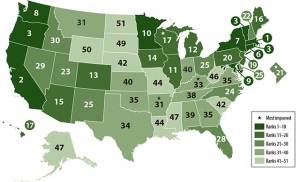
by Brianna Crandall — October 31, 2014—Governors and lawmakers in state capitals across the nation continue to take major steps to lower energy costs, reduce pollution, and save consumers money by increasing their states’ energy efficiency, according to the findings of the 8th edition of the State Energy Efficiency Scorecard just released by the American Council for an Energy-Efficient Economy (ACEEE).
Available online, the report found that in 2014 Massachusetts (#1) continues to edge out California (#2) as the most energy-efficient state in the nation for the fourth year in a row. This year also marks Rhode Island’s first time in the top five. The top 10 states for energy efficiency are:
1. Massachusetts
2. California
3. Rhode Island
3. Oregon
3. Vermont
6. Connecticut
7. New York
8. Washington
9. Maryland
10. Minnesota
From dead last and up, the five states most in need of improvement on energy efficiency in 2014 are North Dakota, Wyoming, South Dakota, Mississippi, and Alaska, says ACEEE.
Other key State Energy Efficiency Scorecard findings include the following:
- Arkansas, the District of Columbia, Kentucky, and Wisconsin are the four most improved states for energy efficiency in 2014. Arkansas pushed forward with strong utility programs. The state’s budgets for electric efficiency programs increased 30% between 2012 and 2013, while electricity savings more than tripled. The District of Columbia and Wisconsin also saw upticks in energy savings. Kentucky took notable steps to adopt a more efficient commercial building energy code.
- Overall, states are ramping up their commitments to energy efficiency. Savings from electricity efficiency programs in 2013 totaled approximately 24.4 million megawatt-hours (MWh), a 7 percent increase over 2011 savings reported last year by ACEEE. Gas savings for 2013 were reported at 276 million therms (MMTherms), a 19 percent increase over the 2011 savings reported in the previous ACEEE State Scorecard.
- A total of 23 states fell in the energy efficiency rankings in 2014. Indiana dropped the furthest, by 13 spots, due in part to state legislators’ decision to eliminate the state’s long-term energy savings goals. Legislators in Ohio made a similar decision to freeze and substantially weaken the state’s energy efficiency resource standard (EERS), contributing to the state’s fall of seven spots down the rankings. Despite these policy setbacks, utilities in both states have indicated they will continue running efficiency programs, albeit at levels below what would have been required by the standards.
- ACEEE found that states that enforce and adequately fund an EERS drive investments in utility-sector energy efficiency programs. The states with the most aggressive savings targets include Arizona, Massachusetts, and Rhode Island.
Other key findings include the following:
- Total budgets for electricity efficiency programs in 2013 reached $6.3 billion. Adding that to natural gas program budgets of $1.4 billion, total efficiency program budgets were estimated to be more than $7.7 billion in 2013.
- The leading states in utility-sector energy efficiency programs and policies were Rhode Island, Massachusetts, and Vermont. With long records of success, all three continued to raise the bar on cost-effective programs and policies. Both Massachusetts and Rhode Island earned maximum points in this category.
- The leading state in building energy codes and compliance was California. Eleven states and the District of Columbia have officially adopted the latest standards for both residential and commercial buildings.
- California and New York led the way in energy-efficient transportation policies. California’s requirements for reductions in greenhouse gas (GHG) emissions have led it to identify several strategies for smart growth, while New York is one of the few states in the nation to have a concrete vehicle-miles-traveled reduction target.
- Other states have also made recent progress in energy efficiency. Nevada scored additional points for its building codes and compliance measures. Delaware passed a significant energy efficiency bill in early July, laying the groundwork for customer-funded energy efficiency programs. This policy shift did not result in an improved score this year, but it will likely garner additional points in future editions of the State Scorecard as programs are implemented and regulations are finalized.
- The U.S. territories of Puerto Rico, Guam, and the U.S. Virgin Islands have taken steps to improve energy efficiency in new construction by adopting building energy codes, but have generally not made investments in efficiency in other sectors. This is the first year these territories have been included in the State Scorecard.
The State Energy Efficiency Scorecard benchmarks states across six policy areas: utility policies and programs, transportation initiatives, building energy codes, combined heat and power development, state government-led initiatives, and state-level appliance standards. In total, states are scored on more than 30 individual metrics. Data is collected from publicly available sources and vetted by state energy offices and public utility commissions.




